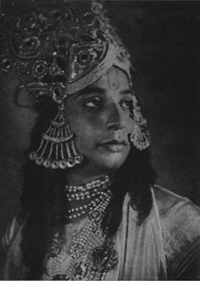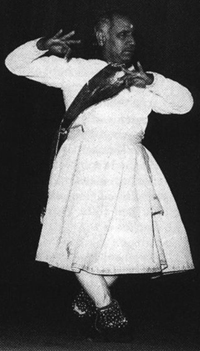
Shambhu Maharaj

Sunder Prasad
The senior Gurus of Lucknow and Jaipur Kathak were such familiar figures during my early years at Kathak Kendra, that I didn’t consider their mortality. I never stopped to think, that some day they would not be in their classroom when I returned to the Kendra after a trip home to the United States. Sunder Prasad-ji passed away on May 30, 1970 and Shambhu Maharaj-ji passed away a few months later, on November 4, 1970. I had been fortunate to observe both of their classes during my early years at Kathak Kendra starting in 1967, but I wish I had seen more of their teaching style and known enough Hindi to understand their piquant sense of humor and pointed comments about their art. I was impressed by the serious drill in executing chakkurs (pirouette turns) given by Shambhu Maharaj-ji to his older son Kishan Mohan. And I had once watched Sunder Prasad-ji rehearsing his star students Devi Lal and Durga Lal when they returned to his classroom after their graduation from Kathak Kendra. Performances by some of the dancers whom both Gurus had taught reflected their vast knowledge and convinced me that Shambhu Maharaj and Sunder Prasad were not only great Kathak dancers and Gurus, but also larger-than-life artists. Their personalities overflowed the usual definition of the term Gharana Dhar, literally “upholder of the house / style.”
When I arrived at Kathak Kendra in 1967, it consisted of a conglomeration of buildings left over from the British Raj, plus two large huts, whose flimsy bamboo and banana leaf walls rose above smooth concrete floors and were topped with thatched roofs. The Kendra offices and several classrooms were located in one of this assortment of decaying structures – a one-story sprawling bungalow, condemned for demolition, but useful until the Kathak Kendra could be re-located. Though the remnants of past grandeur were evident in the marble floors and elegant fireplaces in this building, the plaster was powdering and black mold showed through the regularly white-washed walls. Guru Shambhu Maharaj taught in this bungalow. Gurus Sunder Prasad and Birju Maharaj each taught in a separate straw hut.
The windows remained open in all the buildings except during the coldest months of the Delhi winter, and snatches of conversations, the clack of old Remington typewriters, and the sounds of vocal, pakhawaj and Kathak lessons drifted out. Moreover, even with floor-to-ceiling curtains drawn against the hot winds of the pre-monsoon Loo * and the cold winds of winter, the bamboo huts let all sounds sift out. Kathak Kendra was alive with jingling gungroos, recitation of dance compositions, music, murmuring voices and laughter throughout the day and late into the night. Shambhu Maharaj-ji would occasionally bluster into Birju Maharaji’s hut, dramatically pick a rose from the air, smell it with an exaggerated display of various rasas, then walk out with some comment which I could not understand, since I had not yet learned Hindi. Sunder Prasad-ji’s three year old son, pursued by his mother, would run into Birju Maharaj-ji’s hut, chasing a mouse, who was pursued by a mongoose. It was a lively scene, dominated by serious classes and relieved by occasional humor.
During those early years at Kathak Kendra, I learned the nuances of Kathak’s history by experiencing it, not by reading from books. For example I learned an important lesson about the concept of gharana while eating a meal. I had been told that there was great rivalry among the Gurus of the various gharanas – the styles of Kathak developed in the houses (ghar’s) of Lucknow, Jaipur and Benaras. But the mutual respect exhibited by the two senior Gurus at Kathak Kendra – Shambhu Maharaj of the Lucknow gharana and Sunder Prasad of the Jaipur gharana – eclipsed the supposed rivalry between the two gharanas. In fact Sunder Prasad’s father had sent him to Lucknow at a young age to study with Bindadin Maharaj,the Kathak dancer-guru, whose poetry forms the core of Lucknow gharana repertoire. I learned this when Sunder Prasad celebrated Bindadin Maharaj’s birthday. Birju Maharaj’s hut – the largest room in the entire Kendra because Ballet Unit rehearsals were conducted there – was cleaned, the floor was washed, and banana leaves where spread in several lines on the floor. Vats of food were brought into the hut. Sunder Prasad touched Shambhu Maharaj and Birju Maharaj’s feet and served them food. And then Sunder Prasad’s students served food to him and to the staff and the entire student body. In this way the senior-most Jaipur guru, Sunder Prasad, showed his gratitude to his guru, Bindadin Maharaj of the Lucknow gharana. And in this way I learned that gharana has meaning far and above geographical boundaries.
I wish I had learned a few more lessons before my first of many return trips to my American home. Because the next time I returned to my Indian home, both of these great gurus had passed away. I had not known enough to ask them the many questions I would now ask – were they still living. I could not express my gratitude to these great gurus in words any better than Einstein used to describe his accomplishments – “I stand on the shoulders of giants.”
* hot winds off the Thar Desert